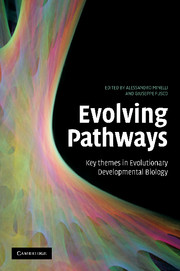Book contents
- Frontmatter
- Contents
- Contributors
- Preface
- Introduction: Pathways of change
- Part I Thinking about evolution by taking development on board
- Part II Evo-devo: methods and materials
- Part III Evolving diversity
- 12 Unravelling body plan and axial evolution in the Bilateria with molecular phylogenetic markers
- 13 Are transposition events at the origin of the bilaterian Hox complexes?
- 14 Many roads lead to Rome: different ways to construct a nematode
- 15 Basal euarthropod development: a fossil-based perspective
- 16 Developmental transitions during the evolution of plant form
- Part IV Evolving body features
- Index
- References
12 - Unravelling body plan and axial evolution in the Bilateria with molecular phylogenetic markers
Published online by Cambridge University Press: 08 August 2009
- Frontmatter
- Contents
- Contributors
- Preface
- Introduction: Pathways of change
- Part I Thinking about evolution by taking development on board
- Part II Evo-devo: methods and materials
- Part III Evolving diversity
- 12 Unravelling body plan and axial evolution in the Bilateria with molecular phylogenetic markers
- 13 Are transposition events at the origin of the bilaterian Hox complexes?
- 14 Many roads lead to Rome: different ways to construct a nematode
- 15 Basal euarthropod development: a fossil-based perspective
- 16 Developmental transitions during the evolution of plant form
- Part IV Evolving body features
- Index
- References
Summary
SETTING THE PROBLEM
The emergence of dramatic morphological differences (disparity) and the ensuing bewildering increase in the number of species (diversity) documented in the fossil record at key stages of animal and plant evolution have defied, and still defy, the explanatory powers of Darwin's theory of evolution by natural selection. Among the best examples that have captured the imagination of the layman and the interest of scores of scientists for 150 years are the origins of land plants from aquatic green plants, of flowering plants from seed plants, of chordates from non-chordates and of tetrapod vertebrates from non-tetrapods; and the conquest of the land by amphibians; the emergence of endotherms from ectotherm animals; the recurrent invention of flight (e.g. in arthropods, birds and mammals) from non-flying ancestors; and the origin of aquatic mammals from four-legged terrestrial ancestors.
Key morphological transitions pose a basic difficulty: reconstruction of ancestral traits of derived clades is problematic because of a lack of transitional forms in the fossil record and obscure homologies between ‘ancestral’ and derived groups. Lack of transitional forms, in other words gaps in the fossil record, brought into question one of the basic tenets of Darwin's theory, namely gradualism, as Darwin himself acknowledged. Since Darwin, however, and especially in the past 50 years, numerous examples that may reflect transitional stages between major groups of organisms have accumulated.
- Type
- Chapter
- Information
- Evolving PathwaysKey Themes in Evolutionary Developmental Biology, pp. 217 - 238Publisher: Cambridge University PressPrint publication year: 2008



